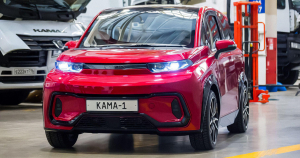
Russia lags behind in push for electric vehicles

Sales of electric vehicles are increasing rapidly all over the world with the pandemic merely accelerating this trend. In an investigation published Monday, The Bell looked at whether Russia can catch up with the pacesetters of ‘electrification’. Even though the Russian government announced ambitious plans last year, the country’s chances seem slim.
- As the revolution in the global car industry gathers pace (between 2012 and 2018, the average annual growth rate of the global electric vehicle market fluctuated between 46 percent and 69 percent), Russia remains on the sidelines. An expert from the Higher School of Economics suggested it was a ‘chicken and egg’ situation: on the one hand, there are so few electric vehicles that there is little profit in creating an infrastructure for them; on the other hand, people won’t buy electric vehicles if they can’t charge them. While Western countries are moving toward electrification, last year’s international leader in terms of both sales (60 percent) and production (48 percent) was China.
- The Russian government decided last year to give a significant boost to the domestic electric vehicle market with the announcement of an ambitious program through 2030 that will increase both production and usage. The overall budget was estimated to be at least 591 billion rubles ($7.6 billion). But most experts see the plans as unrealistic.
- The document envisages that, by 2030, there will be 1.4 million electric cars on Russia’s roads, with 144,000 charging stations. Last year, there were just 12,290 electric cars in the country, and no more than 400 charging stations.
- But ambitiousness isn’t the biggest problem with the program, according to experts. More important is the issue of capacity for charging stations, which could find themselves outdated and unready for new, rapid-charging batteries.
- There are also major doubts about whether 1.4 million electric vehicles could be put on the road in 8 years. According to accounting firm PwC, the electric vehicle market in Russia will grow by an average of 82 percent a year through 2030 — which would mean just 281,000 electric cars on the road by the end of the decade.
- Problems plague the development of Russian-made electric vehicles. The government plans to set up assembly lines for three brands of electric vehicle in the next 3 years: Lipetsk-based Motorinvest will put together the Chinese Changan crossover; a car will is being developed by entrepreneur Denis Shchurovsky’s Zetta project; and the Kama-1 car will be assembled by truckmaker Kamaz and the St. Petersburg Polytechnic University.
- Another potential manufacturer is Avtotor, which is based in Russia’s Western exclave of Kaliningrad. Avtodor is due to localize electric vehicles including the Kia EV6 and the Hyundai Ioniq 5 in 2023. It also has plans for its own electric vehicles.
- Deputy Trade and Industry Minister Alexander Morozov said last year that Motorinvest is expected to be first to the market. Zetta will be hard on its heels. KamAZ is due to open its first electric vehicle factory by the end of 2025.
Why the world should care: Explaining the lack of interest in electric vehicles, experts pointed to few incentives for manufacturers, the absence of obvious benefits for buyers and the high price of vehicles. It appears Russia is at least a decade late with electric vehicles, and it’s hard to imagine it could now catch the market leaders. Perhaps an illustrative comparison is with smartphones: the first Russian-made smartphone only appeared in 2013 — five years after the release of the first iPhone.



